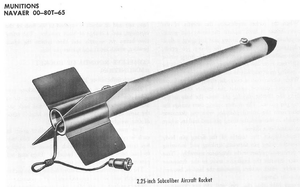2.25-Inch Sub-Caliber Aircraft Rocket
| 2.25-Inch Sub-Caliber Aircraft Rocket | |
|---|---|
 | |
| Type | Training rocket |
| Place of origin | United States |
| Service history | |
| Used by | United States Navy |
| Specifications | |
| Weight | 80 pounds (36 kg) |
| Diameter | 2.25 inches (57 mm) |
| Warhead | None |
|
| |
| Engine | Solid-fuel rocket |
| Speed | 770 mph (1,240 km/h) |
Guidance system | None |
The 2.25-Inch Sub-Caliber Aircraft Rocket, or SCAR, was an American unguided rocket developed by the United States Navy during World War II. Capable of simulating the aerial rockets then coming into operational service, the SCAR was used to train pilots in the use of the new type of weapon, and continued in service throughout the 1950s.
Development
With the introduction of the 3.5-Inch and 5-Inch Forward Firing Aircraft Rockets, a need arose to train aircraft pilots in the proper tactics for the use of the new weapons. This requirement resulted in the development of a dedicated training rocket by the U.S. Navy.[1]
Designated 2.25-Inch Sub-Caliber Aircraft Rocket, the resulting rocket was a joint project between the Bureau of Ordnance and the National Defense Research Committee.[1] As its name implied, the rocket was designed as a sub-calibre weapon compared to the FFAR, being only 2.25 inches (57 mm) in diameter, but weighted to be ballistically similar to the larger operational weapons.[1] Varying the amount of propellant in the SCAR's motor could produce accurate simulations of either type of FFAR's flight characteristics.[1]
Operational history

Following development, SCAR entered full-scale production in January 1945; by July, fully half of the U.S. Navy's rocket production for aircraft use consisted of SCAR rockets.[2] SCAR was widely used during the latter part of World War II as a training round for the FFAR and, later, the High Velocity Aircraft Rocket.[1]
Following the end of the war, it remained in production, continuing in operational service throughout the 1950s.[3] Budget cutbacks prior to the outbreak of the Korean War meant that the SCAR was the only rocket used in training by the majority of pilots.[4]
Despite its small size, SCAR could be hazardous; in 1957, an injury aboard the aircraft carrier USS Kearsarge was caused by the unintended ignition of a SCAR rocket.[5] As recently as 2004, expended SCAR rockets were still occasionally being found in areas that had been used as bombing ranges during World War II.[6]
References
- Citations
- Bibliography
- Douda, Bernard E. (2009). "Genesis of Infrared Decoy Flares: The early years from 1950 into the 1970s (1st Edition)" (PDF). Crane, IN: Naval Surface Warfare Center. Retrieved 2011-01-25.
- Parsch, Andreas (2004). "2.25-Inch SCAR". Directory of U.S. Military Rockets and Missiles. designation-systems.net. Archived from the original on 15 December 2010. Retrieved 2011-01-25.
- Pearson, Lee M. (May–June 1995). "Technical Developments in World War Two" (PDF). Naval Aviation News. Washington, D.C.: U.S. Navy Naval Warfare Division. 77 (4). ISSN 0028-1417. Retrieved 2011-01-25.
- Stewart, James T. (1957). Airpower. Flight, its first seventy-five years. Princeton, NJ: D. Van Nostrand Company. ISBN 0-405-12204-7. Retrieved 2011-01-25.